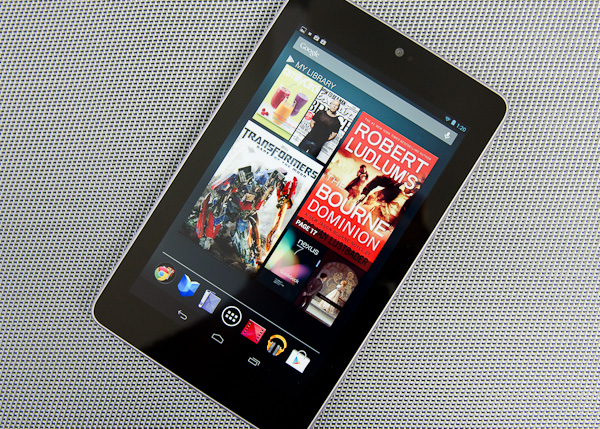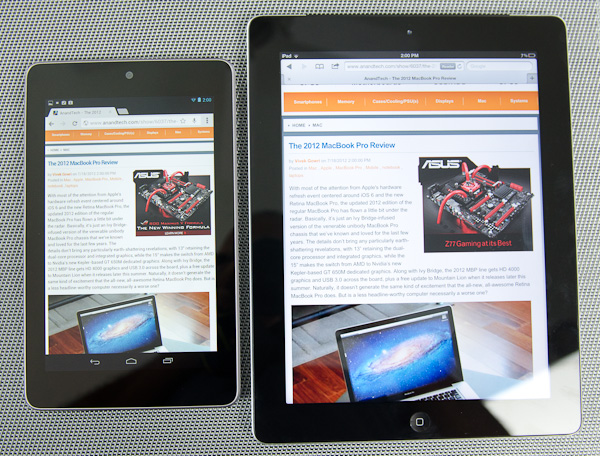The Google Nexus 7 Review
by Anand Lal Shimpi & Brian Klug on July 26, 2012 11:35 AM ESTI viewed Google I/O, Jelly Bean (Android 4.1) and the first Nexus tablet as Google's last chance to deliver a knockout in the tablet space before the onslaught of Windows 8 and Windows RT devices later this year. While the show was undoubtedly a success, I don't know that the market for $499+ Android tablets has a life after Windows 8/RT hit. We should see Windows RT tablets at $499, and Ivy/Haswell based Windows 8 tablets will handle the higher price points.
It seems that Google also realized this as the Nexus 7, its first Nexus branded tablet, starts at just $199. There's a huge market for tablets as a primary computing device, and I believe Windows RT/8 offers something unique and compelling for that usage model. At the same time however, there's decent demand for a tablet to augment your existing computing world. It's a far more specific usage model but one that really demands a lower price point. Users are willing to spend a lot for something that does everything in your life, but for something that's more nice than necessity, price matters even more.
The Nexus 7 is aimed at the latter. It's a device for users who need ultra portability and tons of battery life for content consumption. While Apple has been quietly empowering the iPad to be a content creation device, and dockable Windows 8/RT tablets will attempt to replace your notebook, the Nexus 7 is a more traditional ARM based tablet by default.
It's clearly Google that I have to thank because the Nexus 7 is the most solidly built ASUS tablet I've ever used. That's not to say that its predecessors were examples of shoddy workmanship, it's just that the Nexus 7 is damn near perfect. The back has a great grip to it. The whole thing actually feels like a well made book because of the soft touch plastic back. The book comparison is sort of hilarious because it's a feel that Amazon couldn't get right with its overly generic Kindle Fire. The book illusion stops once your hands touch the glass for obvious reasons, but man does it feel nice to hold.
The Nexus 7 feels considerably lighter than the Kindle Fire, but I still had to prop it up on something or hold it in two hands if I was going to use it for a long period of time.
The power button and volume rocker are placed much like they would be on a phone - at the top right edge of the device. The sole buttons on the device do feel a bit ambiguous, something I feel that I would get used to over time. I had the disadvantage of switching between several tablets during this review and never did get used to the position and feel of the buttons on the N7. That's probably the biggest gripe I have about the design of the device. In other words, there's not much to hate.
The Nexus 7 features two mics for noise canceling action (likely in support of Google Now). You get NFC, Bluetooth and 802.11n WiFi but there's no LTE option as of now. I know there's internal debate about releasing an LTE enabled version at some point in the future.
| ASUS Tablet Specification Comparison | ||||||
| ASUS Transformer Pad Infinity | ASUS Transformer Pad 300 Series | ASUS Eee Pad Transformer Prime | ASUS Nexus 7 | |||
| Dimensions | 263 x 180.6 x 8.4mm | 263 x 180.8 x 9.9mm | 263 x 180.8 x 8.3mm | 198.5 x 120 x 10.45mm | ||
| Chassis | Aluminum + Plastic RF Strip | Plastic | Aluminum | Plastic + Rubber back | ||
| Display | 10.1-inch 1920 x 1200 Super IPS+ | 10.1-inch 1280 x 800 IPS | 10.1-inch 1280 x 800 Super IPS+ | 7" 1280 x 800 IPS | ||
| Weight | 594g | 635g | 586g | 340 g | ||
| Processor |
1.6GHz NVIDIA Tegra 3 (T33 - 4 x Cortex A9) |
NVIDIA Tegra 3 (T30L - 4 x Cortex A9) |
1.3GHz NVIDIA Tegra 3 (T30 - 4 x Cortex A9) | 1.3 GHz NVIDIA Tegra 3 (T30L - 4 x Cortex A9) | ||
| Memory | 1GB DDR3-1600 | 1GB | 1GB | 1 GB | ||
| Storage | 32/64GB + microSD slot | 16GB/32GB + microSD slot | 32GB/64GB + microSD slot | 8 GB / 16 GB | ||
| Battery | 25Whr | 22Whr | 25Whr | 16 Whr | ||
| Pricing | $499/$599 | $379/$399 | $499/$599 | $199/$249 | ||
Cost is the major selling point for the Nexus 7: for $199 Google will sell you an 8GB version with a $25 credit at the Google Play store, along with some preloaded magazines, books and a movie (Transformers: Dark of the Moon). It's tough to buy a new tablet and not buy apps for it, so the $25 credit is likely to be incredibly useful - making the effective retail price of the Nexus 7 $174. If you want 16GB of storage the price does go up to $249 however. Unfortunately even Google is not above charging $50 for $4 of MLC NAND.
The limited NAND capacity prevents the Nexus 7 from being home to more than a single full length movie or a couple of TV shows. Streaming video content isn't a problem, Netflix works beautifully on the device but there's no hope if you want to keep a ton of content local. Unfortunately USB OTG isn't supported for storage, so you're left with no other option for expanding local storage (short of rooting the device).
In every sense outside of portability, a 10-inch display is much nicer to look at than a 7-inch one in my opinion. There's less zooming in you need to do on web pages or magazines. Text in general is just easier to read and perhaps I'm getting too old, but there's something nice about everything being comfortably bigger.
Does the Nexus 7's form factor make it feel substantially better than using a smartphone? Yes, I'd say so. The same reasons I gave above for a 10-inch tablet being nicer to use than a 7-inch tablet are equally applicable to 7-inch tablet vs. a smartphone. There's this size/usability optimization curve that requires some soul searching to figure out exactly where you land on it. I suspect most people fall into the small smartphone + large tablet dichotomy, but the beauty of this current mobile revolution is the availability of choice. The Nexus 7 in many ways is very much like the 11-inch MacBook Air. A bit impractical for many, but those who crave portability are drawn to it. The Nexus 7 still feels like you're using a tablet, just a small one.
I needn't dwell on the benefits of a 7-inch form factor for portability any longer. If I'm wearing baggy enough pants I can even pocket the Nexus 7, something I simply couldn't do with the iPad. I'm more likely to carry the Nexus 7 with me than I would the iPad, but the comparison isn't quite as open and shut as that. The iPad offers LTE, the Nexus 7 is more portable, the iPad is easier to look at, the Nexus 7 is more affordable...the back and forth is endless.



















118 Comments
View All Comments
Death666Angel - Saturday, July 28, 2012 - link
My Chinese tablet and my SGS2 have Wifi set to always on and there is nearly no battery drainage. My SGS2 has standby time of over 5 days with Wifi on and occasional talks. My tablet has standby for over 2 days and I have never gotten it from 100% to <5% battery in a single day so far.Wifi is quite tame these days, I don't see any reason to not have it on all the time.
sjvarley - Friday, July 27, 2012 - link
"the limited NAND capacity prevents the Nexus 7 from being home to more than a single full length movie"Really?
If you need 8GB to store a full length movie on a tablet, then you're using the wrong codec.
tipoo - Friday, July 27, 2012 - link
Yeah, on a 7" screen a 700MB rip should look fine.ssddaydream - Friday, July 27, 2012 - link
I like to use uncompressed MKV.One of the things I would love if Anantech looked at was ability for the tablet to decode various vidoeos.
For example, I've had some trouble playing h264 1080p .MOV files smoothly (it was pretty bad, actually), but I haven't messed with it much yet. I'm confident that a good codec for 1080p content should scale the Nexus 7 display properly and still provide fluid playback.
Death666Angel - Saturday, July 28, 2012 - link
Since the SoC is strong enough to play back anything I throw at it from my normal TV media station, why I should I have to re-encode it for storage sake when storage is about the cheapest thing in the BOM of any tablet? Yes, I can do that, but I gain nothing from it except spend time when a few dollars worth of NAND could have gotten better results.And 700mb for 720p lasts you about 20 to 40 minutes, depending on how many audio streams you have and how much quality you want.
Torrijos - Friday, July 27, 2012 - link
Hi,nice review, as always, but a couple of reviews back you had a plot about device efficiency (a quotient of battery life and battery size).
It would be nice to have a repository article following the evolution of power efficiency with OS updates and the influence of the different CPU architectures.
tukkas - Friday, July 27, 2012 - link
how can the nexus 7 handle a shared device (i.e. multiple family members or guests) who don't want their gmail to necessarily be viewable by all? thank youHacp - Friday, July 27, 2012 - link
Why only bronze? I say if you are looking to buy a tablet without data, the Nexus 7 is at the best price point . Anandtech used to be about price/performance. I'm dissapointed.will2 - Friday, July 27, 2012 - link
An excellent review very thorough in important areas not covered by other reviewers, and with good insights comparing N7 with alternatives.However I think your verdict should list more negatives than limited unexpandable storage. To my mind another serious limitation of the hardware is lack of HDMI out.
I seek a small tablet (with enough memory to hold a reasonable selection of films) I can take around the home and plug into any TV to view, or likewise watch the films at a friends home. I want a tablet to be more multifunction, so when at the bedside it can be both both monitor CCTV and be used as an Alarm Clock Radio as it almost certainly has a FM radio in the same Broadcom chip for the WiFi & BT. Adding HDMI Out, be it via discrete HDMI socket, or cheap USB/MHL solution, and making available the embedded FM Radio, adds neglible cost to the product and makes it more widely useful.
TareX - Friday, August 3, 2012 - link
Then you don't want a $199 tablet.